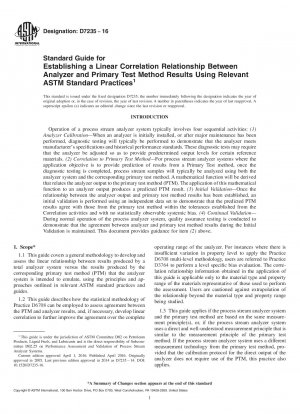ASTM D7235-16
Standard Guide for Establishing a Linear Correlation Relationship Between Analyzer and Primary Test Method Results Using Relevant ASTM Standard Practices
- Standard No.
- ASTM D7235-16
- Release Date
- 2016
- Published By
- American Society for Testing and Materials (ASTM)
- Status
- Replace By
- ASTM D7235-21
- Latest
- ASTM D7235-21a
- Scope
4.1 This guide is intended to be used in conjunction with Practice D3764 (Case 1) and Practice D6122 (Case 2). Methodology in this guide can be used to determine if a linear correlation can improve the performance of the total analyzer system in terms of its ability to predict the results that the PTM would have been if applied to the same material. This methodology, which is based on the same statistical data treatment as Practice D6708, is use to derive the parameters of the linear relationship and to assess the degree of improvement.
4.2 This guide provides developers or manufacturers of process stream analyzer systems with useful procedures for developing the capability of newly designed systems for industrial applications that require reliable prediction of measurements of a specific property by a primary test method of a flowing component or product.
4.3 This guide provides purchasers of process stream analyzer systems with some reliable options for specifying performance requirements for process stream analyzer systems that are used in applications requiring reliable prediction of measurements of a specific property by a primary test method of a flowing component or product.
4.4 This guide provides the user of a process stream analyzer system with useful information on the work process for establishing the PTM prediction relationship and prediction performance.
4.5 Prediction (correlation) relationship obtained in the application of this guide is applicable only to the material type and property range of the materials used to perform the study. Selection of the property levels and the compositional characteristics of the samples must be suitable for the application of the analyzer system. Users are cautioned against extrapolation of the prediction relationship beyond the material type and property range used to obtain the relationship.
4.6 The degree-of-agreement assessment promoted in this guide is based on the statistical principles articulated in Practice D6708, which is purely statistical in nature. No attempt is made in assessing the degree of similarity in the analytical technique between the process analyzer and the PTM; hence, results between the PTM and analyzer unit can be highly correlated, but their measurement principles may be completely different, and may not be the principal cause for correlation. Users are therefore cautioned that a high degree of correlation between results does not necessarily imply a high degree of similarity in the measurement principles; nor does it imply a similar degree of agreement can be expected in future measurements. In general, if sample-specific biases are detected, it suggests that the measurement principles may be different, and may affect the degree-of-agreement in future use of the scaling/bias-correction equation. Presence or absence of sample-specific effect can be used as a measure of the robustness of the correlation equation to sample composition or matrix differences.
4.7 Implementation of this guide requires that the......
ASTM D7235-16 Referenced Document
- ASTM D3606 Standard Test Method for Determination of Benzene and Toluene in Finished Motor and Aviation Gasoline by Gas Chromatography
- ASTM D3764 Standard Practice for Validation of Process Stream Analyzer Systems
- ASTM D4177 Standard Practice for Automatic Sampling of Petroleum and Petroleum Products
- ASTM D5191 Standard Test Method for Vapor Pressure of Petroleum Products (Mini Method)
- ASTM D6122 Standard Practice for Validation of Multivariate Process Infrared Spectrophotometers
- ASTM D6277 Standard Test Method for Determination of Benzene in Spark-Ignition Engine Fuels Using Mid Infrared Spectroscopy
- ASTM D6299 Standard Practice for Applying Statistical Quality Assurance and Control Charting Techniques to Evaluate Analytical Measurement System Performance
- ASTM D6624 Standard Practice for Determining a Flow-Proportioned Average Property Value (FPAPV) for a Collected Batch of Process Stream Material Using Stream Analyzer Data
- ASTM D6708 Standard Practice for Statistical Assessment and Improvement of Expected Agreement Between Two Test Methods that Purport to Measure the Same Property of a Material
- ASTM D7453 Standard Practice for Sampling of Petroleum Products for Analysis by Process Stream Analyzers and for Process Stream Analyzer System Validation
- ASTM D7808 Standard Practice for Determining the Site Precision of a Process Stream Analyzer on Process Stream Material
- ASTM E1655 Standard Practices for Infrared Multivariate Quantitative Analysis*, 2024-04-20 Update
ASTM D7235-16 history
- 2021 ASTM D7235-21a Standard Guide for Establishing a Linear Correlation Relationship Between Analyzer and Primary Test Method Results Using Relevant ASTM Standard Practices
- 2021 ASTM D7235-21 Standard Guide for Establishing a Linear Correlation Relationship Between Analyzer and Primary Test Method Results Using Relevant ASTM Standard Practices
- 2016 ASTM D7235-16 Standard Guide for Establishing a Linear Correlation Relationship Between Analyzer and Primary Test Method Results Using Relevant ASTM Standard Practices
- 2014 ASTM D7235-14 Standard Guide for Establishing a Linear Correlation Relationship Between Analyzer and Primary Test Method Results Using Relevant ASTM Standard Practices
- 2010 ASTM D7235-10 Standard Guide for Establishing a Linear Correlation Relationship Between Analyzer and Primary Test Method Results Using Relevant ASTM Standard Practices
- 2005 ASTM D7235-05 Standard Guide for Establishing a Linear Correlation Relationship Between Analyzer and Primary Test Method Results Using Relevant ASTM Standard Practices

Copyright ©2024 All Rights Reserved